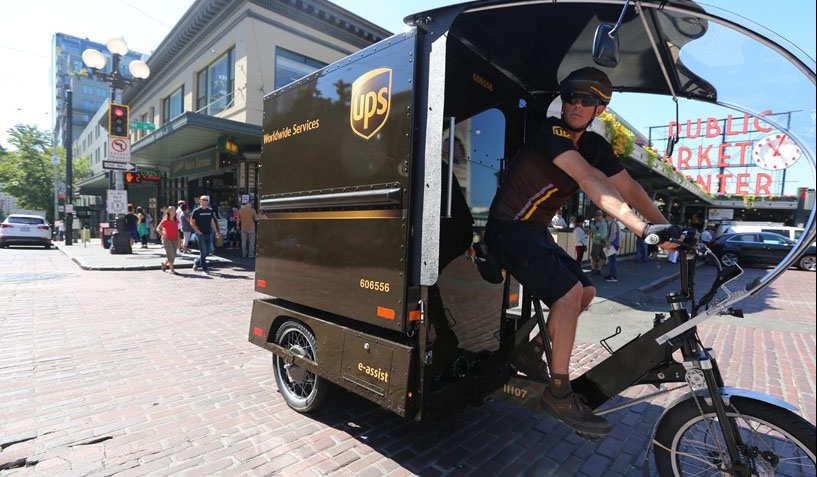This study evaluated the pilot test of a cargo e-bike delivery system in Seattle, Washington, with the intent of providing information to help the city in developing future urban freight policies.
Deliveries in urban areas are usually performed by fleets of cargo vehicles such as trucks and vans. While e-commerce is increasing the demand for urban deliveries, many carriers are also trying to reduce their environmental footprint and cut their carbon emissions. Consequently, there is a need to find new ways to sustainably deliver goods in urban areas while still efficiently and profitably satisfying the increasing demand.
One delivery strategy being tested relies on the complementary use of cargo e-bikes to make last-mile deliveries. Cargo e-bikes are two/three/four-wheeled vehicles with cargo carrying capacity. They are human-powered and often have an electric pedal assist.
In November 2018, the United Parcel Service, Inc. (UPS) pilot tested the use of an electric-assisted tricycle with a removable cargo container to perform last-mile deliveries and pick-ups in downtown Seattle. Cargo containers were pre-loaded daily at the UPS Seattle depot and loaded onto a trailer, which was then carried to a parking lot in downtown.
Researchers at the Supply Chain Transportation and Logistics Center (SCTL) at the University of Washington collected data in two phases. In the “before-pilot” phase, they obtained data from truck routes that operated in the same areas where the cargo e-bike would operate. In the one-month “pilot” phase, data came from the cargo e-bike route and from truck routes that simultaneously delivered in the same neighborhoods. The researchers subsequently compared the performance of the cargo e-bike system with that of the traditional, truck-only delivery system.
In analyzing data from the before-pilot phase the researchers focused on three metrics of truck delivery activity: time spent cruising for parking, delivery distance, and dwell time. They found the following:
- On average, truck drivers spent about 2 minutes cruising for parking for each delivery trip, representing 28 percent of total trip time. On average, a driver spent about 50 minutes a day cruising for parking.
- Most deliveries were about 98 feet (30 meters) from a vehicle’s stop location, which is less than the length of an average block in downtown Seattle (328 feet, 100 meters). Only 10 percent of deliveries were more 328 feet from a vehicle’s stop location.
- Most truck dwell times were around 5 minutes.
Four other metrics were used to evaluate and compare both study phases: delivery area, number of delivery locations, number of packages delivered, and failed first delivery rate. The following were the results:
- The trucks and cargo e-bike delivered approximately in the same geographic areas during both phases, with no significant changes in the trucks’ delivery areas before and during the pilot.
- The number of establishments to which the cargo e-bike delivered in a single tour was found to be 28 to 31 percent of the number of delivery locations visited, on average, by a truck in a single tour.
- The cargo e-bike delivered on average to five establishments per hour, representing 25 to 30 percent of the establishments visited per hour by a truck.
- The cargo e-bike delivered 20 to 24 percent of the number of packages delivered by a truck during a single tour, on average.
- Both before and during the pilot, the failed delivery rate (percentage of packages that were not delivered throughout the day) was approximately 0.8 percent. The cargo e-bike had a statistically significantly lower fail rate of 0.5 percent, with most tours including no failed first deliveries.
Author: Anne V. Goodchild, UW Department of Civil and Environmental Engineering
Sponsor: Seattle Department of Transportation

